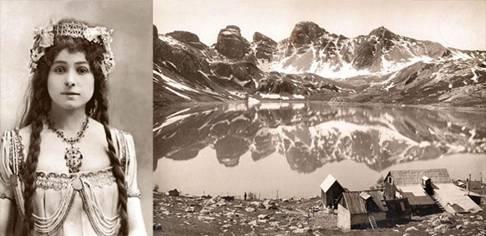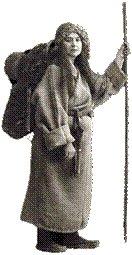 Great characters of Universal Gnosticism
Great characters of Universal Gnosticism  Alexandra DAVID-NEEL (1868-1969)
Alexandra DAVID-NEEL (1868-1969)
Alexandra DAVID-NEEL (1868-1969) |

|

|
| Written by Editor VOPUS | |
|
Alexandra DAVID-NEEL, (1868, Paris – 1969), was the first woman who managed to get inside the Tibetans’ forbidden city, Lhasa. She had one of the most adventurous and spiritual existences from the last century, she traveled several times to Tibet and approached through study and direct practice of the teachings of the Tibetan initiates. In her books, she presented to the occidental world, besides the geographic and the ethnographic description of the visited regions, precious information about the Tibetan doctrines, about the rituals of the lamas and their methods of spiritual training. 
Born in Paris, Alexandra David studied Oriental Languages at Sorbonne and at College de France. She was part of the Theosophical Society, at the Parisian center of which she even lived for a period. During her youth she was a feminist and an anarchist – she wrote a treaty about anarchism, translated in 5 languages (among which Russian). She studied canto and even had a short lyrical period, crossing Europe for several years in opera tours. In 1891 she received a small inheritance that she used to take a first ‘true trip’ to India, trip that lasted one year and a half. After this first contact with the Indian culture, her most ardent desire was to return in the Himalayan solitudes and find out as much as possible on oriental doctrines, on Buddhist, Lamas and Taoist magic and mysticism. Before leaving again for the Extreme Orient, she made a detour through North Africa, being also interested on the world of Moslem spirituality. In Tunis she met Philippe Neel, a reach engineer working at the Railroads, with whom she married. He financed, for thirty years, her travels and her oriental researches. In 1911 start the series of great expeditions that will make her famous. Strong and active, perseverant and intuitive, Alexandra wanted very much to go to Lhasa, the capital of Tibet, absolutely forbidden to strangers and even more to women. She lived for three years in a small Himalayan village, Sikkim, and she visited all the monasteries in the region. In such a monastery she met the young lama Aphur Yongden, who will accompany her from that moment on in all her travelling. Later on, in France, Alexandra adopted him legally. Alexandra Davis-Neel and Lama Yongden get on the Tibetan territory in two stages, reaching the sacred centers Jigatze and Gyantze (more importing according to the vain authors, than Lhasa). In 1916, as a result of these expeditions, Alexandra got expelled from Sikkim, from the order of the British superintendent of the region, because the British were suspecting that the ex anarchist’s travels had other purposes than the researches on Tibetan Buddhism. The explorer didn’t return to Europe because of the war, and continued her travels to Japan, Korea and China. She spent three years of studies and meditations – at Dalai Lama’s advice, who had allowed her a meeting (during the exile on the Chinese territory) – at Kum-Bum monastery, close to the great lake Kuku-Nor, region with Tibetan population. Alexandra left Kum-Bum trying to hide her identity, in order not to draw the attention of the British, also present on the Chinese territory. But her presence was anyway signaled, being obliged to return towards Kuku-Nor. 
Without abandoning not even for a second the Tibetan project, in 1942 she left for the fifth time towards the forbidden region of the ‘Country of Snows’ (name given by the Tibetans to their own country), this time from the British mission at Ynuan, accompanied only by Lama Yongden. This would be a successful expedition, and she represented the subject of Alexandra David-Neel’s first book, book called ‘My journey to Lhasa’ (1927). During the entire period of her travels, she confronted with an entire series of difficulties, but her efforts were rewarded by profound spiritual experiences. So, a trip that was said to last a couple of months lasted fourteen years. She assimilated the Tibetan way of life, ending by preferring it to the European one and becoming Lady-Lama, title that proves that she had been accepted in the Tibetan Buddhist religious world. 
Alexandra returned for a time in France. She settled in Provence, at Digne-les-Bains, in a small estate that she called Samten-Dzong – ‘Fortress of meditation’ – that became in 1977 the headquarters of the David-Neel Foundation. She was recognized as authority in the matter of esoteric doctrines and made big conference tours in Europe, accompanied by her adoptive son, Lama Yongden. In 1937, the two left again in China, where they met the communist leader Mao (several times) but also the French theologian Teilhard de Chardin. Because of the war between China and Japan, they remained in China more than they had in mind losing all their things and arriving only in 1946, exhausted and ill, in India, from where they could repatriate. At Digne-les-Bains, Alexandra continued to write her books, but always kept alive the desire to leave again for Tibet. At the age of over one hundred years, little before she died, Alexandra David-Neel was asking for her passport to be renewed... She wrote 30 books on oriental spirituality, most of them translated in English too:

Comments (0)
 Write comment
|
| < Pythagoras, the Magician of the Numbers | Carl Gustav Jung (1875-1961) > |
|---|
| Science |
| Art |
| Philosophy |
| Mysticism/Religion |
| Barbelo: Gnosis Magazine |